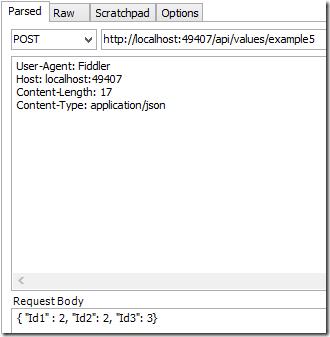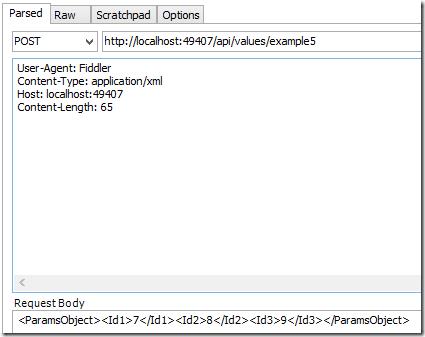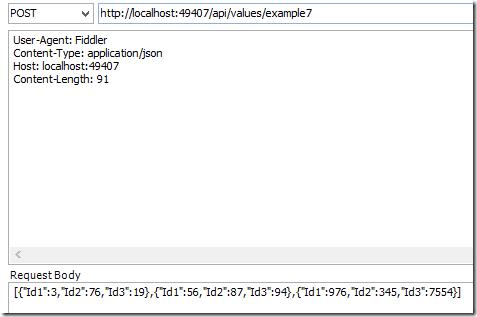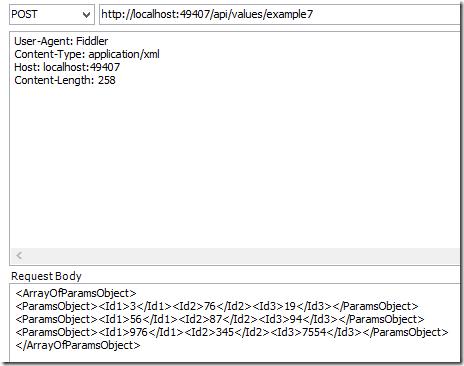WebAPI 2参数绑定方法
Posted Look Into Coding
tags:
篇首语:本文由小常识网(cha138.com)小编为大家整理,主要介绍了WebAPI 2参数绑定方法相关的知识,希望对你有一定的参考价值。
简单类型参数
Example 1: Sending a simple parameter in the Url
[RoutePrefix("api/values")]
public class ValuesController : ApiController
{
// http://localhost:49407/api/values/example1?id=2
[Route("example1")]
[HttpGet]
public string Get(int id)
{
return "value";
}
}
Example 2: Sending simple parameters in the Url
// http://localhost:49407/api/values/example2?id1=1&id2=2&id3=3
[Route("example2")]
[HttpGet]
public string GetWith3Parameters(int id1, long id2, double id3)
{
return "value";
}
Example 3: Sending simple parameters using attribute routing
// http://localhost:49407/api/values/example3/2/3/4
[Route("example3/{id1}/{id2}/{id3}")]
[HttpGet]
public string GetWith3ParametersAttributeRouting(int id1, long id2, double id3)
{
return "value";
}
Example 4: Sending an object in the Url
// http://localhost:49407/api/values/example4?id1=1&id2=2&id3=3
[Route("example4")]
[HttpGet]
public string GetWithUri([FromUri] ParamsObject paramsObject)
{
return "value:" + paramsObject.Id1;
}
Example 5: Sending an object in the Request body
[Route("example5")]
[HttpPost]
public string GetWithBody([FromBody] ParamsObject paramsObject)
{
return "value:" + paramsObject.Id1;
}
注意 [FromBody] 只能用一次,多于一次将不能正常工作
Calling the method using Urlencoded in the body:
User-Agent: Fiddler Host: localhost:49407 Content-Length: 32 Content-Type: application/x-www-form-urlencoded id1=1&id2=2&id3=3
Calling the method using Json in the body:
User-Agent: Fiddler
Host: localhost:49407
Content-Length: 32
Content-Type: application/json
{ "Id1" : 2, "Id2": 2, "Id3": 3}

Calling the method using XML in the body
This requires extra code in the Global.asax
protected void Application_Start()
{
var xml = GlobalConfiguration.Configuration.Formatters.XmlFormatter;
xml.UseXmlSerializer = true;
The client request is as follows:
User-Agent: Fiddler
Content-Type: application/xml
Host: localhost:49407
Content-Length: 65
<ParamsObject><Id1>7</Id1><Id2>8</Id2><Id3>9</Id3></ParamsObject>
数组和列表(Array,List)
Example 6: Sending a simple list in the Url
// http://localhost:49407/api/values/example6?paramsObject=2,paramsObject=4,paramsObject=9
[Route("example6")]
[HttpGet]
public string GetListFromUri([FromUri] List<int> paramsObject)
{
if (paramsObject != null)
{
return "recieved a list with length:" + paramsObject.Count;
}
return "NOTHING RECIEVED...";
}
Example 7: Sending an object list in the Body
// http://localhost:49407/api/values/example8
[Route("example8")]
[HttpPost]
public string GetListFromBody([FromBody] List<ParamsObject> paramsList)
{
if (paramsList != null)
{
return "recieved a list with length:" + paramsList.Count;
}
return "NOTHING RECIEVED...";
}
Calling with Json:
User-Agent: Fiddler
Content-Type: application/json
Host: localhost:49407
Content-Length: 91
[{"Id1":3,"Id2":76,"Id3":19},{"Id1":56,"Id2":87,"Id3":94},{"Id1":976,"Id2":345,"Id3":7554}]
Calling with XML:
User-Agent: Fiddler Content-Type: application/xml Host: localhost:49407 Content-Length: 258 <ArrayOfParamsObject> <ParamsObject><Id1>3</Id1><Id2>76</Id2><Id3>19</Id3></ParamsObject> <ParamsObject><Id1>56</Id1><Id2>87</Id2><Id3>94</Id3></ParamsObject> <ParamsObject><Id1>976</Id1><Id2>345</Id2><Id3>7554</Id3></ParamsObject> </ArrayOfParamsObject>
Example 8: Sending object lists in the Body
[Route("example8")]
[HttpPost]
public string GetListsFromBody([FromBody] List<List<ParamsObject>> paramsList)
{
if (paramsList != null)
{
return "recieved a list with length:" + paramsList.Count;
}
return "NOTHING RECIEVED...";
}
This is a little bit different to the previous examples. The body can only send one single object to Web API. Because of this, the lists of objects are wrapped in a list or a parent object.
POST http://localhost:49407/api/values/example8 HTTP/1.1
User-Agent: Fiddler
Content-Type: application/json
Host: localhost:49407
Content-Length: 185
[
[
{"Id1":3,"Id2":76,"Id3":19},
{"Id1":56,"Id2":87,"Id3":94},
{"Id1":976,"Id2":345,"Id3":7554}
],
[
{"Id1":3,"Id2":76,"Id3":19},
{"Id1":56,"Id2":87,"Id3":94},
{"Id1":976,"Id2":345,"Id3":7554}
]
]
自定义参数
What if the default parameter binding is not enough? Then you can use the ModelBinder class to change your parameters and create your own parameter formats. You could also use ActionFilters for this. Many blogs exist which already explains how to use the ModelBinder class. See the links underneath.
文件和二进制
Files or binaries can also be sent to Web API methods. The article demonstrates how to do this.
参考
http://aspnet.codeplex.com/SourceControl/latest#Samples/WebApi/CustomParameterBinding/
http://www.asp.net/web-api/overview/formats-and-model-binding/parameter-binding-in-aspnet-web-api
http://www.roelvanlisdonk.nl/?p=3505
http://stackoverflow.com/questions/14628576/passing-an-json-array-to-mvc-web-api-via-get
以上是关于WebAPI 2参数绑定方法的主要内容,如果未能解决你的问题,请参考以下文章



